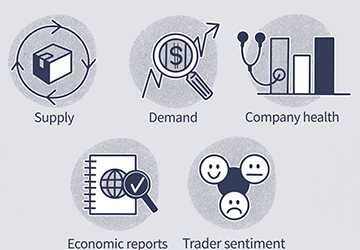7 Warning Signs of Poor Stock Performance
Picture this: you have been a prudent investor and put your own money in a particular stock, but one day, you start wondering, 'Was this a wise decision? Sound familiar?
This is how you can identify signs that indicate poor stock performance to prevent falling victim to fraud.
If these red flags are addressed on time, the investor may avoid significant losses and make the proper investment decisions.

This article will examine seven key signs that warn that a particular stock might be headed for trouble. Examining a company's financial statements or tracking market movements has excellent power.
These quick and practical tips will ensure that your portfolio remains protected. Well, let's find out how to identify potential stock risks before they shake your profit margin!
Understanding Stock Performance Indicators
Evaluative tools, precisely stock performance indicators, are essential for investors as they provide information on a company's financial health, market position, and prospects for growth.
They act as a compass that helps investors navigate the stock market, which is rather challenging.
Just think about buying a business without any information on the company's sales growth, the debt and equity ratios, or its earnings. It is like attending a competition, knowing full well that you will compete, but you must learn to swim.
Share market indices eliminate that veil, providing a crystal vision of a firm's advantages and disadvantages.
They include stock market figures and trends such as the P/E ratio and debt-equity ratio, the rate of insider trading among critical shareholders, and many more. Both offer different insights on how a firm is fairing in the market.
For instance, a high P/E ratio could represent elevated growth prospects, while a low ratio could mean that the stock is cheap or that its growth has been disappointing.
Through these indicators, investors gain insight into some companies within the same industry. They help answer crucial questions.
A fundamental question that every investor would like to ask is this: is the company financially sound? Is it possible to observe the growth or the opposite, the stagnation? What do you say about its standing in the competition with similar products?
Learning about stock performance indicators is essential because it puts you in a better position than your competitors.
7 Warning Signs of Poor Stock Performance
Following a comprehensive background on the stocks' performance indicators, proceeding to the seven significant caution signals indicating a stock is in trouble is necessary.
If you know these markers early on, you can avoid such bad investments and protect your portfolio.
1. Declining Financial Health
The first is a clear threat if a company shows poor financial standing. If you realize that revenue, earnings, or cash flow are constantly falling, then it is time to check on something.
For example, suppose TechCorp has presented its quarterly reports, and you find that its profits have declined for the last year.
In that case, it can signal heightened competition or wrong strategic decisions. Be on the lookout for any drastic movements in any of these numbers; if you see such a movement, it should be looked into.
2. Ballooning Debt Levels
Yet another factor that should attract attention is the company's debt burden. However, it is essential to understand that debt is sometimes harmful and may be necessary.
Still, there is a significant difference between average and rapidly accumulating debt. If a company loads more debt than it can manage, it may need help to service the interest or fund future growth.
If EnergyX's debt-to-equity ratio has increased dramatically in the last few quarters, it could indicate that the company is gearing up for a financial crisis and is close to economic peril.
3. Frequent Management Turnover
Constant leadership changes are unsuitable for the organization's growth and must be avoided. If you see a lot of movement in the C-suites, this might be a sign that the company is in trouble or needs to figure out where it is going.
Just think how RetailMart has had three different chief executives in the last two years–that is a lot of turmoil at the head of the organization.

Even though management turnovers are expected, constant changes in the guard may adversely impact the company's performance and cause uncertainty among investors.
4. Industry Headwinds
At other times, the problem may be with something different than the individual firm but the whole sector. Challenges such as regulatory changes or shifts in consumer trends, if experienced in the industry, can hurt or even pull down the giants.
For instance, if technological advancements lead to greater government regulation and fewer car owners in the automobile industry, businesses like CigaretteCo may need help selling their products and generating profits.
Therefore, it is wise to be aware of the trends in this field and how they will affect your investments.
5. Negative Media Attention
The rapid speed at which news travels these days can be catastrophic for a company's reputation and stock market value once the media turns against the firm.
If you're a company facing a product recall, a legal issue, or a social media firestorm, you have a problem.
This is because if BeverageBrand is in the media for adverse events, this may be a sign of something wrong within the company. Monitor the news and social media buzz to assess the possible effects of going through with them on your portfolio.
6. Losing Market Share
Market share is another essential parameter that reflects a firm's competitive standing in the market in which it operates.
Suppose a company constantly loses ground to its competitors. In that case, it may be because customers are turning away because of its products and services, which are better than the competitors' products and services.
The company may need help to market its products and services correctly.
For example, if the company's smartphone market share constantly shrinks while competitors enter new, promising positions, it may be time to reconsider your investment.
Frequent checks of industry reports and competitive intelligence are needed to assess market share position.
7. Unusual Insider Activity
Finally, monitoring the level of insider trading in the specific stock might be helpful. Another sign indicating insider selling is when senior managers or board directors offload large blocks of their stock.
Insiders trade their shares for several reasons, including to fund personal expenses, pay for education, or divorce. However, a massive spike in selling activity may suggest a need for more confidence in the company's future performance.
However, if a streak of some unusual insider selling is observed in BioTechCorp, there might be an issue to explore.
Conclusion
It is a wise decision in the business investment field to be able to identify the earliest signs that a particular stock is performing poorly.
Implement these considerations in your investment so you do not fall victim to these conditions. Remember that identifying good stocks is only complete with a strategy of identifying bad stocks.
To take charge of the financial outcome as an investor, one must be vigilant and knowledgeable of the trends and apply these lessons now. Well done, your portfolio will be grateful to you!
FAQs
Q: What should I do if I notice declining earnings in a stock I own?
A: If earnings are slipping, check out the latest balance sheets and income statements to discover why. It could also compare with similar products sold in the market regarding efficiency. If positions decline for fundamental reasons or managerial misdeeds, selling the company's stocks is wiser. One must also listen and read to ensure that their investments are safe.
Q: How can I determine if a company has high debt levels?
A: Use the company's balance sheet and look into the total debt and debt-to-equity ratio. The high value suggests high borrowing or debt securities in the company or industry. This information is also available on financial news websites and stock analysis platforms.





